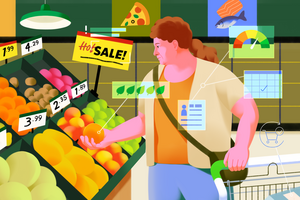There is a white lie that dieters often tell themselves: adding a side salad to their cheeseburger will help them lose weight. The logic defies simple arithmetic—adding any amount of calories to a meal only increases the total number. “And yet our research shows that consumers often behave as if pairing an indulgent meal with a healthy option makes the whole meal seem less fattening,” says Alexander Chernev, professor of marketing at the Kellogg School of Management. “The prevalence of this behavior when it comes to food and dieting raises the question of whether people display a similar bias in other domains, such as price perception.”
Chernev and his collaborator, Aaron Brough of Pepperdine University, set out to investigate this phenomenon in the context of an established retailing practice. Bundling products from different price tiers happens all the time, whether by design—as in a sales promotion that offers a $100 printer with a $2000 computer—or simply because tossing different items into a shopping cart can combine them in the consumer’s mind.
“Economic and behavioral theories make mixed predictions about the effect that bundling can have on purchasing decisions,” says Chernev. Some theories predict that combining two items can have a superadditive effect on the consumer’s overall perception of value, making the whole greater than the sum of its parts. For example, consumers might be willing to pay more for a matching chair and sofa set than for the same chair and sofa considered separately. Other theories predict a subadditive effect, in which the bundled items are perceived to be worth less than the sum of their individual valuations. For example, Disney World visitors are often willing to pay less for a bundle of tickets than for the individual tickets considered separately.
From Calories to Prices
In contrast, Chernev and Brough document a subtraction effect in which combining items in different price tiers not only decreases customers’ willingness to pay for the bundle but also diminishes how much they value the more expensive item considered by itself. “This subtraction effect is a very extreme case of the subadditive scenario,” Chernev says, “and one that is directly analogous to the side-salad illusion. When we show people a burger and ask them how many calories it has, they might say 500. For a side salad, they might say 100. But if you pair the same burger with the side salad, people will often think that the whole meal has fewer calories—say 400—than the burger alone. That seems counterintuitive, as if the salad somehow has ‘negative’ calories.” In the same way, Chernev points out, combining a $100 printer with a $2000 computer can reduce consumers’ willingness to pay, making them perceive the bundle as worth less than the value of the computer alone.
People tend to classify items into categories such as expensive or cheap, and this classification influences their willingness to pay for these items.
Brough and Chernev devised a set of five experiments to document and investigate this subtraction effect, pairing expensive items with inexpensive items (for example, a home gym and a fitness DVD, or a luxury-brand jacket and a bargain-brand jacket) and comparing participants’ willingness to pay for the bundle versus their willingness to pay for the expensive item alone. They found that in some cases adding an inexpensive item to an expensive one reduced participants’ willingness to pay by as much as 45%. They also found that this type of bundling did not just impact the dollar value participants were willing to pay; it also affected the choices they made. For example, in one of the experiments the percentage of participants who chose a home gym over a one-year gym membership dropped by 31% when the home gym was bundled with a fitness DVD.
Averaging without Numbers
Like the dieter’s mental math, this does not add up. How could considering a cheap product alongside an expensive one actually subtract value from the combination in the buyer’s mind? According to Chernev, the effect stems from consumers’ tendency to think in terms of categories instead of numbers. People tend to classify items into categories such as expensive or cheap, and this classification influences their willingness to pay for these items. “Categorical judgments are relative,” Chernev explains. “Healthy versus unhealthy, short versus long, expensive versus inexpensive—these don’t really have numeric value.” Juxtaposing two products from conspicuously different price tiers, like a $100 printer and a $2000 computer, encourages consumers to treat them as categorical opposites—there is an “expensive” one and an “inexpensive” one—then jointly evaluate them in a process Chernev and his coauthor call “categorical averaging.”
Chernev explains that even though there are not numeric values associated with these categories, combining them results in a process that is akin to numeric averaging. When you have to mentally combine the categories of “expensive” and “inexpensive,” your mind settles on something in between: kind of moderately expensive. This way of thinking can make the printer and the computer seem less valuable as a package deal—just like the salad and the burger seem to have fewer calories when evaluated together.
Fatal Subtraction?
But where categorical averaging in terms of calories may result in a more expensive order at the drive-through, categorical averaging in terms of prices can result in consumers’ diminished willingness to pay in a retail context. “Categorical judgment influences your numerical estimates,” Chernev explains. “If you perceive an item to be very expensive, then you’re willing to pay more. But if you perceive something to be only moderately expensive, then you’re willing to pay less for it.”
Does this mean that marketers should not bundle cheap items with higher-priced fare? “Not necessarily,” Chernev cautions. “Bundling products from different price tiers might be effective because it could allow retailers to target different market segments. But our findings suggest that retailers should be careful when offering these combinations. If they do it in a way that encourages consumers to see the items as categorical opposites in price, it can have a negative impact.”
Brough, Aaron, and Alexander Chernev. 2012. “When Opposites Detract: Categorical Reasoning and Subtractive Valuations of Product Combinations.” Journal of Consumer Research. 39: 399–414.


